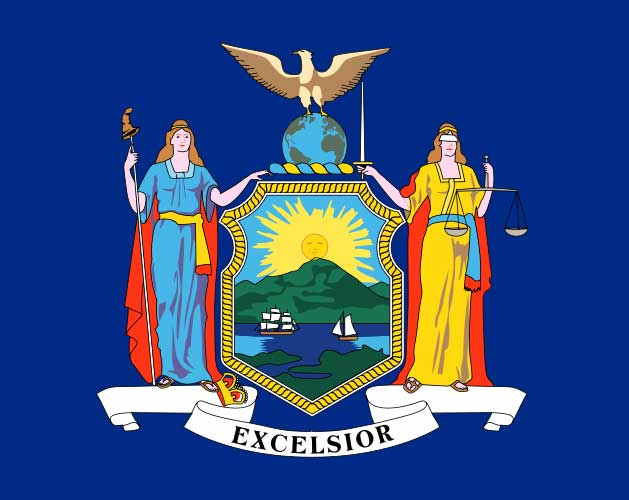New York


Basic Information
Postal Abbreviation: NY
Natives: New Yorker
Population 2020: 20,201,249
Legal Driving Age: 18
(*17 w/ Drivers Ed.)
Age of Majority: 18
Median Age: 38
State Song: I Love New York
Median Household Income:$66,852
Mean Household Income:$92,816
Capital..... Albany
Entered Union..... July 26, 1788 (11th)
Present Constitution Adopted: 1777
(last revised in 1938)
Nickname: Empire State
Excelsior State
Motto:
“Excelsior” (Ever upward)
Origin of Name:
Originally named New Netherlands
by Dutch. In 1664, the area was renamed by the British in honor of
the Duke of York.
USS New York
Railroad Stations
New York Economy
AGRICULTURE: apples, cattle, corn,
eggs, grapes, flowers, fruit, milk, pears,
poultry, vegetables.
MINING: clays, salt, stone.
MANUFACTURING: book publishing,
chemicals, clothing, electronics, food
processing, instruments, machinery,
metals, paper products, printing, toys.
![]()

New York Geography
Total Area: 53,989 sq. miles
Land area: 47,224 sq. miles
Water Area: 6,765 sq. miles
Geographic Center: Madison
12 mi. S of Oneida and
26 mi. of Utica
Highest Point: Mount Marcy (5,344 ft.)
Lowest Point: Atlantic Ocean (sea level)
Highest Recorded Temp.: 108˚ F (7/22/1926)
Lowest Recorded Temp.: –52˚ F (2/18/1979
The eastern part of New York State is mountainous. The Adirondack mountains lie on the North Eastern part of the state. Its highest peak is Mount Marcy at 5,112 feet. The western part of the state is primarily flat, slowly descending into Lake Champlain. The Hudson River is the largest River in the state. The St. Lawrence forms 100 miles of the northern border. Part of Lakes Erie, Ontario, and Champlain are in the state. Long Island stretches 120 miles from the mouth of the Hudson into the Atlantic, creating a body of water known as the “Long Island Sound”.
Cities
New York, 8,398,748
Buffalo, 256,304
Rochester, 206,284
Yonkers, 199,663
Syracuse, 141,683
Albany, 93,523;
New Rochelle, 78,742
Mount Vernon, 67,924
Schenectady, 61,280
Utica, 59,336
New York History
1524 Giovonni de Verrazano entered New York Bay.
1614 The first Dutch trading post was established near Albany.
1625 Dutch settler found the colony of New Netherlands. They pay the Indians 60 guilders for the island of Manhattan.
1664 Governor Stuyvesant surrendered New Amsterdam to the British who
rename the city New York.
1688 Huguenots settler establish New Rochelle, the home town of
MultiEducator, Inc.
1754 Kings College later renamed Columbia University is founded.
1776 The British defeated American troops at the battle of Long Island.
Lord Howe’s troops then occupied Long Island. A few days later Nathan
Hale was executed for being an American spy. In October British an
American forces fought to a draw at the Battle of White Plains.
1777 American forces won a decisive victory at the battle of Saratoga.
1783 Washington bid farewell to his troops in New York.
1787 Alexander Hamilton published the first volume in what became know as
the Federalist Papers.
1789 George Washington was inaugurated as the first President on the steps of
Federal Hall in New York.
1802 The US military academy, known as West Point was founded.
1807 Robert Fulton's steamboat Clermont sails from New York to Albany in 32
hours.
1812 American troops defeated the British in the Battle of Lake Champlain.
1825 The Erie Canal was opened.
1848 The first Women's Convention was held at Seneca Falls.
1863 Draft riots took place in New York that resulted in 1,000 casualties.
1899 President William McKinley was assassinated in Buffalo.
1904 The first subway opened in New York city.
1927 Charles Lindbergh flies to Paris from New York.
1929 Panic on the New York stock exchange launches the great depression.
1965 Black Nationalist Malcolm X was assassinated in New York.
1976 New York which on the brink of bankruptcy is aided by a federal loan
guarantee.
2001 Two planes hijacked by terrorist crash into the World Trade Center destroying both towers
Famous People
Humphrey Bogart ;
Benjamin N. Cardozo
Aaron Copland r;
Sammy Davis, Jr.
George Eastman
Millard Fillmore
Lou Gehrig baseball
George Gershwin
Charles Evans Hughes
Washington Irving a
John Jay
Chico, Groucho, Harpo, and Zeppo Marx
Herman Melville
John D. Rockefeller
Norman Rockwell
Mickey Rooney
Anna Eleanor Roosevelt
Franklin D. Roosevelt
Theodore Roosevelt
Jonas Salk
Margaret Sanger
Beverly Sills
Martin Van Buren
Mae West
Walt Whitman
.png)
New York National Sites
1) Womens Rights National Historic Park
In 1848 Elizabeth Cady Stanton and four other women invited the public to the First Women's Rights Convention to discuss expanding the role of women in America
2)Fort Stanwix National Monument
For centuries, the Oneida Carrying Place, a six mile portage connecting the Mohawk River and Wood Creek, served as a vital link for those traveling by water from the ocean to the Great Lakes.
3) Saratoga National Historical Park
Here in the autumn of 1777, American forces met, defeated and forced a major British army to surrender. This crucial American victory in the Battle of Saratoga renewed patriots’ hopes for independence, secured essential foreign recognition and support, and forever changed the face of the world.
4)Martin Van Buren National Historic Site
Politics before the Civil War was a whirlwind of opposing interest groups. Martin Van Buren was able to unite those groups becoming president in 1837.
5)Home of Frankllin D Roosevelt
The first US Presidential Library was started by FDR here. Visit the Home of FDR and Presidential Library & Museum to learn about the only President elected to four terms.
6)Theodore Roosevelt Inaugural National Historic Site
As president, Theodore Roosevelt created protections for ordinary citizens, began regulation of big business, and made the US a major force in international affairs. Yet one of the most important presidencies in America's history nearly didn't happen. See the place where a brief, emotional, and improvised ceremony in Buffalo, NY brought TR into office, and forever altered the nation.
7)Fire Island National Seashore
Fire Island has been a special place for diverse plants, animals and people for centuries. Far from the sounds and pressures of nearby big-city life, Fire Island National Seashore's dynamic barrier island beaches offer solitude and camaraderie, and spiritual renewal to civilization-weary people.
8)Statue of Liberty National Monument
The Statue of Liberty Enlightening the World was a gift of friendship from the people of France to the people of the United States and is a universal symbol of freedom and democracy. The Statue of Liberty was dedicated on October 28, 1886, designated as a National Monument in 1924 and restored for her centennial on July 4, 1986.
8)lGeneral Grant National Memorial
The final resting place of President Ulysses Simpson Grant and his wife, Julia, is the largest mausoleum in North America. It testifies to a people’s gratitude for the man who ended the bloodiest conflict in American history as Commanding General of the Union Army and then, as President of the United States, strove to heal a nation after a civil war and make rights for all citizens a reality.
 >
>